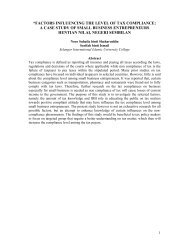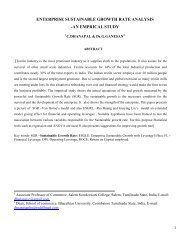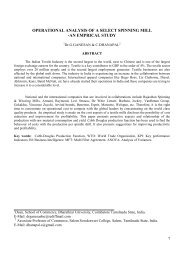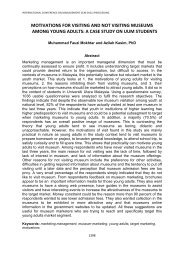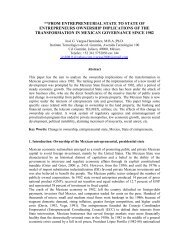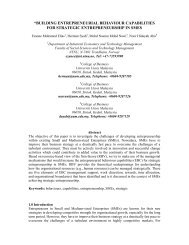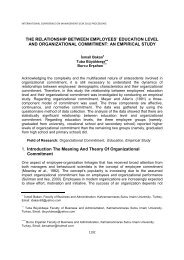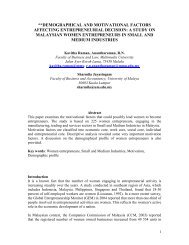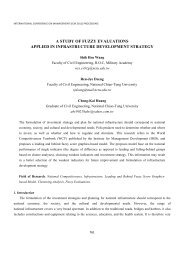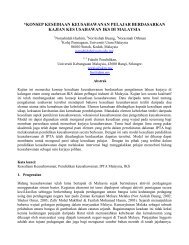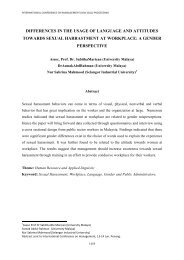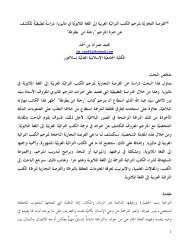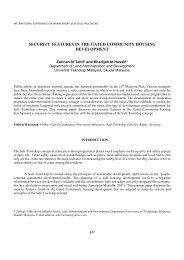Medical tourism - International Conference, Call For Paper ...
Medical tourism - International Conference, Call For Paper ...
Medical tourism - International Conference, Call For Paper ...
Create successful ePaper yourself
Turn your PDF publications into a flip-book with our unique Google optimized e-Paper software.
MEDICAL TOURISM<br />
“INVESTIGATING THE CONTRIBUTING FACTORS TO<br />
MEDICAL TOURISM IN MALAYSIA AND IT’S IMPACT ON<br />
PROFITABILITY”<br />
Shamini Kandasamy FCCA, MBA<br />
Universiti Tunku Abdul Rahman<br />
&<br />
Puspavathy Rassiah ACMA, MBA<br />
Universiti Tunku Abdul Rahman<br />
ABSTRACT<br />
This research is designed to investigate the factors which can enhance medical <strong>tourism</strong> in<br />
Malaysia. These factors can be identified through the empirical evidence that was collected<br />
by means of interviews with hospital administrators. Some competitive advantages from<br />
successful medical <strong>tourism</strong> spots such as Thailand and Singapore had also been identified.<br />
<strong>For</strong> the past few years the number of medical patients who visited Malaysia had been growing<br />
gradually, however it was not sufficient as compared with its neighbouring countries. There<br />
were fewer tourists who sought medical treatment in Malaysia. As a result, it had an impact<br />
on Malaysia’s economy. Firstly, it reduced the revenue generated from health industry.<br />
Secondly, there were fewer tourists who visited Malaysia and thus decreased the profit of<br />
<strong>tourism</strong> industry. Lastly, it minimised the number of jobs available in Malaysia and led to<br />
unemployment. In a nutshell, this study was conducted in order to investigate various ways to<br />
attract medical tourists to Malaysia and increase Malaysia’s profit from medical <strong>tourism</strong>.<br />
Keywords: <strong>Medical</strong> Tourism, Factors Affecting Revenue, Malaysia.<br />
1
1.0 Introduction<br />
<strong>Medical</strong> <strong>tourism</strong> refers to the many patients that are currently traveling overseas for immediate and<br />
affordable treatment. Caballero-Danell and Mugomba (2007) defines medical <strong>tourism</strong> as the pursuit of<br />
medical care abroad and simultaneously engage in more conventional forms of <strong>tourism</strong>.<br />
According to Daub’s study (as cited in Newman, 2006), medical <strong>tourism</strong> is the attempt by many<br />
Americans to save money by traveling to other countries for their medical needs. This focuses on the<br />
Americans while others define differently.<br />
Keckly and Underwood (2008)<br />
noted that medical <strong>tourism</strong> is the process of “leaving home” for<br />
treatments and care abroad or elsewhere domestically. It is an emerging phenomenon in the health care<br />
industry.<br />
In addition, according to Horowitz and Rosensweig (2007), “medical tourists” seek modern health care<br />
at affordable prices in countries at variable levels of development. <strong>Medical</strong> <strong>tourism</strong> is different from<br />
the traditional form of international medical care where patients typically journey from less developed<br />
nations to major medical centers in highly developed countries for advanced medical treatment. This<br />
means even patients from a highly developed country such as The United States can go to those<br />
developing countries such as Malaysia and its neighbours for medical treatment.<br />
In short, medical <strong>tourism</strong> is the attempt by patients to seek for a qualified and high quality medical<br />
health care at foreign countries at an affordable price or cheaper price. It does not limit to traveling to<br />
modern countries to seek for better service but most important is the affordable price with the same<br />
quality of service. This combination of surgery and <strong>tourism</strong> is a relatively new type of nonexclusive<br />
niche <strong>tourism</strong> that promises to have significant growth over the next few years.<br />
Connell (2005) found as health care costs have increased tremendously, patients in the developed world<br />
are looking overseas for medical treatment. Patients in developed countries always suffer from long<br />
waiting time. They have to take turns to wait for the medical treatment. Thus, consumers commit to<br />
travel overseas for their medical treatment. Often, consumer will also take the opportunity to be a<br />
2
tourist in the visiting country and enjoy what it has to offer. Therefore, consumers may combine their<br />
holiday and medical care into one venture.<br />
Besides that, medical tourists seek for medical <strong>tourism</strong> because those foreign countries offer a better<br />
price with the same service provided. Patients also travel to medical <strong>tourism</strong> destinations for<br />
procedures that are not available in their own countries such as stem cell therapy for heart failure.<br />
Other reasons for medical <strong>tourism</strong> are the natural attractiveness in the foreign countries, the medical<br />
expertise and the medical quality.<br />
Horowitz and Rosensweig (2007) mentioned that medical <strong>tourism</strong> is market driven which is shaped by<br />
the complex interactions a combination of medical, economic, social and political forces. All of these<br />
are interrelated and needed to be developed in order to become a competitive medical <strong>tourism</strong>.<br />
1.1 Background<br />
Calvin, C. and Ivy, T. (2005) mentioned medical <strong>tourism</strong> in Asia is relatively new. <strong>Medical</strong> <strong>tourism</strong><br />
was brought on in the aftermath of the Asian Financial Crisis that led private hospitals to seek<br />
alternative revenue sources. Malaysia started to be actively participating in medical <strong>tourism</strong> since 1998<br />
with the setting up of the National Committee for The Promotion of <strong>Medical</strong> and Health Tourism. In<br />
Malaysia, the medical solutions range from traditional medicine to telemedicine.<br />
Under Malaysia’s health <strong>tourism</strong> promotion drive, there are 35 private hospitals in Malaysia which<br />
have been chosen to promote Malaysia as a health tourist destination. These 35 private hospitals are<br />
members of the Association of Private Hospitals of Malaysia (APHM). Besides that, these hospitals<br />
have been awarded the certification for internationally recognised standards for example MS 9002 or<br />
accreditation by the Malaysian Society for Quality in Health and ISO 9001 Gupta (2005).<br />
Malaysia achieved some success in establishing as a regional hub for good health care and its ability in<br />
providing state-of-the-art medical facilities and services for medical tourists (Ministry of Health). All<br />
of these successes were due to the combination of hard efforts by Association of Private Hospitals of<br />
3
Malaysia, Ministry of Tourism, Tourism Malaysia, MATRADE, the government agencies and the<br />
private agencies.<br />
Malaysia became a centre of medical excellence because of its high quality medical facilities and<br />
services plus its highly trained and qualified medical specialists and staffs (Tourism Malaysia, 2007).<br />
Malaysia’s natural attractiveness and most importantly the competitive medical fees provide additional<br />
attractions to enrapture medical tourists to Malaysia.<br />
1.2 Issues<br />
Globalisation has caused many countries to re-evaluate their economical strengths and weaknesses, as<br />
well as re-assess what products or services in which nations can benefit Morrison (2003). Nowadays,<br />
medical <strong>tourism</strong> has grown tremendously in many countries such as Thailand and India. In 1990’s,<br />
many Asian countries became the victims in Asian economic crisis. Thus, they need to find economic<br />
diversification and solutions to settle this crisis. Malaysia is one of those countries. As a result, those<br />
Asian countries started to involve in medical <strong>tourism</strong>.<br />
In table 1.2.1is the statistics which shows the number of medical tourists who came to Malaysia has<br />
been increasing from year to year.<br />
Table 1.2.1: Number of <strong>International</strong> Patients and Revenue<br />
Year Number of <strong>International</strong> Patients Revenue [(RM) ’million]<br />
2001 75,210 44.3<br />
2002 84,585 35.8<br />
2003 102,946 58.9<br />
2004 174,189 104.9<br />
2005 232,161 150.9<br />
2006 296,687 203.7<br />
2007 341,288 253.84<br />
(Source from APHM)<br />
Through this statistical data, we understand that Malaysia has experienced an increasing number of<br />
medical tourists over the years. However, Malaysia is still experiencing a smaller scale of medical<br />
tourists compared to its neighbour countries such as Thailand and Singapore. According to Keckly and<br />
Underwood (2008), in 2006:<br />
<br />
Singapore attracted an estimated 410,000 medical tourists.<br />
4
Malaysia attracted an estimated 300,000 medical tourists.<br />
Thailand attracted an estimated 1,200,000 medical tourists.<br />
While in the year of 2007, India attracted an estimated 450,000 medical tourists. The data stated above<br />
reveals Malaysia is the country that has least medical tourists. This small amount of medical tourists<br />
indirectly reflects the quality and the reputation of our country’s medical <strong>tourism</strong>.<br />
1.3 Statement of the Problem<br />
Table 1.2.1 showed the number of patients and the revenue generated from medical <strong>tourism</strong> in<br />
Malaysia starting from the first year of medical <strong>tourism</strong> in Malaysia to year 2007. The number of<br />
foreign tourists does have a relationship with foreign earnings and revenue. The increasing number of<br />
foreign tourists in Malaysia will cause the foreign earnings and revenue in Malaysia increase too.<br />
However according to the data provided by Keckly and Underwood (2008), we know that Malaysia has<br />
experienced smaller scale of medical tourists compared to neighbor countries. As a result, Malaysia<br />
was having a lower foreign earnings and revenue from the medical <strong>tourism</strong> industry. Other than that,<br />
Chan, K. E. (2009) said due to the economic slowdown, some medical tourists may postpone their<br />
treatments which are not serious such as cosmetic surgery and knee surgeries in Malaysia. This even<br />
makes the problem worse.<br />
This delay would have an impact on hospitals which offer these services, hence reduce the inflow to<br />
these hospitals and have a domino effect creating a reduction in the inflow of funds through medical<br />
<strong>tourism</strong>.<br />
According to the data provided by Keckly and Underwood (2008), the medical patients who came to<br />
Malaysia for medical treatment were fewer than our neighbour countries. From this point of view, there<br />
was a serious problem. Without a solution to this problem, Malaysia will be unable to compete with its<br />
neighbours causing a loss in potential revenue.<br />
5
1.3 Research Objective and its significance<br />
The main purpose of this research is to identify the effective factors for attracting international patients<br />
to Malaysia. This could be done by identifying and examining the contributing factors to medical<br />
<strong>tourism</strong> in Malaysia. Effective contributing factors refer to the factors that can identify, gain, maintain<br />
and improve the current condition of Malaysia’s medical <strong>tourism</strong>. However, the contributions to<br />
medical <strong>tourism</strong> in Malaysia are not sufficient enough. We identify the ways to create a competitive<br />
advantage in Malaysia medical <strong>tourism</strong> through the factors and contributions of medical <strong>tourism</strong> which<br />
are currently practiced by corresponding organisations and institutions (Malaysia government, medical<br />
care provider, travel agency).<br />
We also identify the factors and competitive advantages that are being adopted by other popular<br />
medical <strong>tourism</strong> destinations such as Thailand and Singapore, so that it could be imitated or adopted by<br />
Malaysia medical <strong>tourism</strong>. The products, services they provide and the strategy they adopt maybe the<br />
significant factor to the success achievement.<br />
Our research aims to identify the contributing factors to Malaysia’s medical <strong>tourism</strong> and the potential<br />
competitive advantages that could improve this industry. Understanding and adopting these<br />
contributions, competitive advantages and factors are necessary to enhance the medical <strong>tourism</strong> in<br />
Malaysia. With this we are able to understand the factors that can attract more foreign patients to<br />
Malaysia, which are unavailable in Malaysia yet. These factors can be fully or partly utilised by<br />
Malaysia medical <strong>tourism</strong> in order to compete with our neighbour countries and gain more earnings<br />
from medical <strong>tourism</strong>. This can assist the Malaysian government in promoting its medical <strong>tourism</strong> to<br />
global, designing health care plan, medical <strong>tourism</strong> policy, and others. The <strong>tourism</strong> industry can gain<br />
more foreign inflow, by attracting more medical tourists, the <strong>tourism</strong> industry can gain more foreign<br />
earnings as the medical tourists will also spend time and travel to some popular destinations in<br />
Malaysia. Other than private hospitals and health care providers, many related industries might get<br />
benefit from them, such as the hospitality industry. Usually most of the patients travel with family and<br />
friends. Therefore it multiplies the revenue several times.<br />
6
These factors and competitive advantages will able to improve the current status of medical <strong>tourism</strong> in<br />
Malaysia and attract more medical tourists to Malaysia. Besides, it helps Malaysia to become a global<br />
medical hub. Therefore, by attracting more international patients, the revenue and profit will be<br />
increased and it benefits many other related industries.<br />
LITERATURE REVIEW<br />
2.1 <strong>Medical</strong> Tourism<br />
<strong>Medical</strong> <strong>tourism</strong> or medical travel is the act that patients travel to other countries obtaining medical,<br />
dental, and surgery care. Almost two decades ago, Goodrich & Goodrich (1987) defined health-care<br />
<strong>tourism</strong> as “the attempt on the part of a tourist facility (for example a hotel) or destination to attract<br />
tourists by deliberately promoting its health-care services and facilities, in addition to its regular tourist<br />
amenities”. It is a new and niche industry that combines leisure and health care. The definition of<br />
medical <strong>tourism</strong> and wellness <strong>tourism</strong> were equally interchangeable in Europe during the 1960’s and 1970’s,<br />
it refer to a combination of leisure and health-care, the facilities referred to 20 years ago generally<br />
included spas, resorts, hot springs, were added to this definitions. Connell (200 5) defined medical<br />
<strong>tourism</strong> as a niche industry “where people often travel long distances to oversea countries to obtain<br />
medical, dental and surgical care while simultaneously being holidaymakers, in a more conventional<br />
sense”(p.1094). The emergence of medical <strong>tourism</strong> satisfies the needs for the growing number of<br />
foreign patients, mainly in developed countries. This not only benefits foreign patients but also those<br />
medical <strong>tourism</strong> destinations, principally in developing countries. Another definition of <strong>Medical</strong><br />
<strong>tourism</strong> is it occurs when international patients travel across boundaries for their healthcare and<br />
medical needs Monica (2007).<br />
2.2 The rise of medical <strong>tourism</strong> in Asia<br />
Surprisingly, some Asian countries such as Thailand, Singapore, Malaysia, India, South Korea<br />
attracting a combined 1.3 million medical tourists per year from around the world, and is increasing<br />
annually. The main region of medical <strong>tourism</strong> is shifting to Asia in this decade. It is projected to<br />
generate more than US$4 billion by 2012 Gupta (2007). Besides that, there are many other countries<br />
seeking to enter this new industry such as Latin America, Eastern Europe, South Africa countries. Even<br />
7
Dubai, a well known destination of luxury vacation, is scheduled to open the Dubai Healthcare City by<br />
2010 Shyam (2007). In fact, Thailand known as a destination for medical <strong>tourism</strong> as early as 1970s<br />
because of its specialisation in sex change operations and later moved into cosmetic surgery Connell<br />
(2005). Other than that, Malaysia involved in medical <strong>tourism</strong> after 1998 in the awake of the Asian<br />
economic crisis and the need for economic diversification. India advertised itself as offering everything<br />
from alternative Ayurvedic therapy to coronary bypasses and cosmetic surgery. Bumrungrad<br />
<strong>International</strong> in Thailand and Apollo in India are among those well known medical <strong>tourism</strong> destinations.<br />
2.3 <strong>Medical</strong> Tourism today<br />
The reasons people travel oversea for medical care are high cost and long wait time (United State s,<br />
United Kingdom) at native country, new technology and skill in destination countries alongside with<br />
reduced transport costs and internet marketing Connell (2005). Besides, Connell states that the rise of<br />
medical <strong>tourism</strong> emphasises the privatisation of health care, the growing dependence on technology,<br />
uneven access to health resources, the accelerated globalisation of both health care and <strong>tourism</strong>.<br />
Another research such as Kazemi (2008) conducted a research on determining the effective factors for<br />
attracting medical tourists to Iran and examined the actual potential that foreign patients represent<br />
based on costs, quality and recognising other aspect of marketing mix. Kazemi (2008) also investigated<br />
the role of the government and related organisations. In order to provide a better understanding of the<br />
current status of medical <strong>tourism</strong> and anticipated development, Mugomba and Caballero Danell (2006)<br />
have developed a map document all information collected.<br />
Figure 2.3.1: The Health Tourism Structure<br />
8
Mugomba and Caballero-Danell (2006) expressed that the market description is based on an analysis<br />
made by the medical <strong>tourism</strong> reality, consisted of what services operators offer, how countries market<br />
their destinations and package then with medical treatments, the social issues that have arisen and the<br />
effects of the absence of a legal framework to keep up with the development of the medical <strong>tourism</strong><br />
niche market. This analysis also explains how infrastructure in medical <strong>tourism</strong> destinations are<br />
changing in order to host tourists that are also patients by giving special attention to the safety and<br />
technological requirements, among other things, in an effort to compete against medical institutions in<br />
various regions for the medical tourist’s disposable income.<br />
2.4 The trend of medical <strong>tourism</strong> concept in the world<br />
The concept of medical <strong>tourism</strong> or health travel in the world was mooted in 1997, after Asian<br />
economic crises. The concept of Health Tourism, <strong>Medical</strong> Tourism, <strong>Medical</strong> Travel and <strong>Medical</strong><br />
Outsourcing are the same. All of these concepts define as traveling abroad to receive health care and<br />
treatment. In 1990 many factors in different countries such as Asian countries led to the growth of<br />
medical <strong>tourism</strong> in the long term will continue. According Jabbari, the trend concept of medical <strong>tourism</strong><br />
from 1997 to 2007 has shown below:<br />
1997 --- Health <strong>tourism</strong><br />
1997-2001 --- Transition<br />
2001-2007 --- <strong>Medical</strong> <strong>tourism</strong><br />
2006-2007--- <strong>Medical</strong> outsourcing<br />
The term “outsourcing” is defined as “a practice used by different companies to reduce costs by<br />
transferring portions of work to outside suppliers rather than completing it internally”. So, medical<br />
outsourcing which is also commonly known as medical <strong>tourism</strong> is the practice of seeking health care<br />
abroad. As successful outcomes of medical <strong>tourism</strong> become more evident, demand is likely to increase<br />
further. Western insurance companies might encourage overseas treatment to reduce their own costs. A<br />
hospital in Kolkata which is in West India has signed an agreement with the British insurance company,<br />
BUPA (Connell, 2005). Moreover, some larger Indian companies have been in negotiations with the<br />
NHS about outsourcing the treatment of British patients to India Connell (2005).<br />
9
Earlier, people went abroad mostly for elective cosmetic procedures which were not covered by<br />
insurances. Today, people outsource their orthopedic procedures as well as cardiac surgeries and organ<br />
transplants. It’s not just individuals who are interested in this trend to save money. <strong>Medical</strong> outsourcing<br />
has also received attention from health insurance companies who have started offering overseas treatment<br />
plans to expand their customer base, and from employers who have included it as a benefit to their<br />
employees Kazemi (2008).<br />
With the time past, the objectives of medical travel in past (old model) have changed to a new medical<br />
aspect of <strong>tourism</strong> (new market of today). The objectives for old model which was called medical travel can<br />
be divided to three main factors: self-paying clients from the Middle East, Asia or Latin America<br />
seeking care in the USA or Western Europe; specialists targeted on those where quality care and<br />
advanced equipments are not available in home countries; patients’ requirement for emergency care<br />
that not available in home countries.<br />
The objectives of new model (new market) can be classified into many factors. It was called medical<br />
<strong>tourism</strong> and has been expressed as waiting list lines for elective procedures in many developed<br />
countries such as England, opportunities to offer first class services at third world cost and<br />
combination of surgery with sightseeing tours. All these factors led the patient from developed counties to<br />
developing countries.<br />
2.5 <strong>Medical</strong> <strong>tourism</strong> in Malaysia<br />
Statistics indicated a strong and growing interest in Malaysia’s healthcare <strong>tourism</strong> industry. According<br />
to Association of Private Hospitals Malaysia (APHM), the number of foreigners seeking healthcare<br />
services in Malaysia has grown from 75,210 patients in year 2001 to 296,687 patients in year 2006<br />
which generated a total of RM203.66 million (USD 59 million) in revenue. This trend is likely to grow<br />
at a rate of 30 percent a year until 2010, projected by Association of Private Hospitals Malaysia<br />
(APHM).<br />
Tourism Malaysia, in collaboration with APHM and the Ministry of Health, has introduced tourist<br />
brochures and other promotions on Health Tourism in Malaysia for distribution throughout the world.<br />
10
The brochure will promote Malaysia as a health tourist destination and will list the 35 private hospitals<br />
and 20 travel agencies in the country, which are participating in health <strong>tourism</strong>.<br />
Much of Malaysia’s attraction lies in the wide array of medical services and procedures including<br />
dental, cosmetic and cardiac surgeries at significantly lower costs compared with the United States.<br />
Also, foreign medical tourists and investors are attracted by Malaysia’s favourable exchange rate,<br />
political and economic stability and high rate of literacy, since Thailand still suffered from the political<br />
instability, some foreign medical tourist will choose Malaysia as their alternative for medical <strong>tourism</strong><br />
destination, Nuwire Investors (2008).<br />
Competitive medical fees and modern medical facilities are two vital factors that make Malaysia a<br />
popular destination among health tourists. Patients can undergo treatment and recuperate in any part of<br />
the country for less than what it would cost them for a treatment in other countries. <strong>For</strong> example, a<br />
normal cardiac bypass surgery (CABG) in Malaysia would cost only between US$6,000 and US$7,000<br />
(Tourism Malaysia, 2007).<br />
To ease entry formalities for patients, the Immigration Department of Malaysia has implemented the<br />
Green Lane System at main entry points which expedites custom clearance for medical tourists.<br />
Accompanying family members or friends of the patient can take advantage of their visit to Malaysia’s<br />
various interesting tourist attractions. Cities like Kuala Lumpur and Penang offer a truly<br />
comprehensive range of both health and <strong>tourism</strong> services, all within easy reach (Tourism Malaysia,<br />
2007).<br />
Besides the Ministry of Health, a committee was formed to assist the promotion of health <strong>tourism</strong>. It<br />
comprised of the Ministry of Tourism, the Association of Private Hospitals of Malaysia and other<br />
government agencies such as the Malaysian Association of Tours and Travel Agencies, Malaysian<br />
Airlines and several private hospitals. This committee was called “The National Committee for the<br />
Promotion of Heath Tourism in Malaysia”. Membership of the committee has also been extended to<br />
several other agencies such as the Malaysian Industrial Development Authority, the Malaysian<br />
Association of Tour and Travel Agencies, Malaysian Airlines System, the Primary Care Doctors’<br />
11
Organisation of Malaysia, and a few other tertiary hospitals.<br />
5 subcommittees were formed to realise the references or objectives of The Committee, namely:<br />
i. Health Tourism (Subcommittee for the identification of countries suitable for health <strong>tourism</strong><br />
promotion);<br />
ii.<br />
iii.<br />
iv.<br />
Inland Revenue Department (Subcommittee on Tax Incentives);<br />
Association of Private Hospital Malaysia (Subcommittee on Fee Packaging);<br />
Health Ministry’s Development Division (Subcommittee on Advertisement);<br />
v. Health Ministry’s Pharmacy Division (Subcommittee on Accreditation).<br />
The Committee had been cooperating with other agencies in carrying out promotional activities<br />
concerning health <strong>tourism</strong> in the country. This included collaborations with the Malaysian External<br />
Trade Development Corporation (MATRADE) through its trade missions; Tourism Malaysia through<br />
its promotional activities; various state governments; private hospital groups and the Association of<br />
Private Hospitals Malaysia.<br />
Most of the promotional activities have been done in collaboration with MATRADE through its trade<br />
missions; Tourism Malaysia through its travel marts; various state governments, notably Melaka, Pulau<br />
Pinang and Selangor; and private hospital groups, notably Kumpulan Perubatan Johor and the<br />
Association of Private Hospitals Malaysia (APHM).<br />
MATRADE export promotion activities for the healthcare sector includes participation in international<br />
trade fairs, specialised marketing missions as well as trade investment mission led by the Minister of<br />
<strong>International</strong> Trade and Industry. MATRADE has also been working closely with other Ministries and<br />
agencies to promote the export of healthcare sector, such as the Ministry of Health and Association of<br />
Private Hospitals of Malaysia.<br />
In Malaysia, all private medical centres are approved and licensed by the Ministry of Health. Most of<br />
the private medical centres have achieved certification for internationally recognised quality standards,<br />
for example, MS ISO 9002 or accreditation by the Malaysian Society for Quality of Health (MSQH).<br />
12
Accreditation or certification under ISO 9002 will be an invaluable testimony to the quality of our<br />
healthcare services and will give us the competitive edge over our rivals.<br />
2.6 Model<br />
In our research conducted, the structure of the analysis is according to each of the five forces of<br />
Porter’s model, “Porter’s 5 forces analysis”. Thee 5 components inside this model which includes 3<br />
forces from ‘horizontal’ competition (rivals, new entrants, and substitute products) and 2 forces from<br />
‘vertical’ competition (bargaining power of supplier and buyer). As one of our research objectives is to<br />
determine the factors that allow Malaysia to gain more revenue from its medical <strong>tourism</strong> industry,<br />
Porter’s 5 forces analysis was significant. This model is applicable to our research topic because we<br />
need to analyse all the five components in order for Malaysia to gain more revenue from its medical<br />
<strong>tourism</strong> industry. According to Harvard professor Michael Porter, the five industry forces determine an<br />
industry’s overall attractiveness and potential for long-term profitability.<br />
RESEARCH METHODOLOGY<br />
Mixed method is one of the research techniques used in this research which will be examined and<br />
explained further on in this chapter. According to Cohen and Manion (1986) define triangulation as an<br />
“attempt to map out, or explain more fully, the richness and complexity of human behavior by studying<br />
it from more than one standpoint”. By combining data sources, methods, investigators and theories,<br />
triangulation opens the way for richer and potentially more valid interpretations for the view of medical<br />
<strong>tourism</strong>. Readers can get a complete view of our case study, the idea can be described as the attempt on<br />
the part of the contributing factors to medical <strong>tourism</strong> in Malaysia and its impact on profitability.<br />
Primary data is accumulated by the researcher particularly to meet up the research objective of the<br />
subsisting project. With the usage of primary data, we got to know the trend of medical <strong>tourism</strong> in<br />
Malaysia.<br />
A set of questionnaire was composed, in order to collect information from the hospital<br />
administrators. These questions were used during our interviews with hospital administrators and key<br />
management personnel in Pantai <strong>Medical</strong> Centre, Ampang Puteri Specialist Hospital and HSC <strong>Medical</strong><br />
Centre.<br />
13
Realising that obtaining information around Klang Valley alone is not enough, we decided to explore<br />
further by sending our questionnaire by email to other hospitals in Peninsular Malaysia. We had<br />
conducted an email survey with the Director of Corporate Development in Penang Adventist Hospital<br />
(www.pah.com.my). He provided us very detail information regarding about our topic. The information<br />
we obtained is well governed and accurate. After the analysing of the information, the idea of our<br />
results of the topic is more visible and supportive.<br />
Secondary data was collected and analysed to convene the requirements of various research objectives.<br />
It is available effortlessly, rapidly and inexpensively. By surfing the internet we managed to obtain lots<br />
of information and same goes to reading the secondary sources of information from brochures, articles,<br />
journals regarding medical <strong>tourism</strong> worldwide. Another way to triangulate data is the notes which we<br />
had taken during and immediately after each interview session. These include information we obtained<br />
from interviews with the hospital administrators from Pantai <strong>Medical</strong> Centre, Ampang Puteri Specialist<br />
Hospital and HSC <strong>Medical</strong> Centre. These notes were especially useful as they shed additional light on<br />
the textual contents or indicate specific questions that did not directly appear in the interview<br />
transcripts.<br />
3.4 Sampling Method<br />
Our target population is the private hospitals that provide medical services for foreign patients. Overall<br />
there are thirty five private hospitals which provide this service which we obtained from the<br />
Association of Private Hospital of Malaysia (APHM). Simple random sample was used to select fifteen<br />
out of thirty five private hospitals. Simple random sample means all such subsets of the frame are<br />
given an equal probability.<br />
However, due to the large number of hospitals, we used judgmental sampling method to choose ten out<br />
of the fifteen private hospitals. We focused on the hospitals that patients used to patronage in seeking<br />
medical treatment. Finally, we have chosen convenience sampling method to obtain information. From<br />
this method, we have selected three private hospitals that are willing to help us by giving us feedback<br />
in doing this survey.<br />
14
The sampling method which was written above is based on qualitative method. As for the email survey,<br />
quantitative method is adopted by sending the questionnaire to the other balances of private hospitals.<br />
However, only one private hospital replied.<br />
The main purpose of this questionnaire is to seek out those factors about medical <strong>tourism</strong>. Through this<br />
questionnaire, we managed to understand more about medical <strong>tourism</strong> in Malaysia and even worldwide.<br />
<strong>For</strong> example: What are the differences between Malaysia’s hospital and overseas hospitals in the<br />
perspective of the medical equipments? All these questions have been compounded into appendix.<br />
4.0 ANALYSIS AND FINDINGS<br />
4.1 Asia as a <strong>Medical</strong> Tourism Destination of Choice<br />
Figure 4.1.1: Distribution of international tourists in less developed countries<br />
Many countries in Asia such as South Korea, Singapore, India, Thailand and Malaysia are actively<br />
promoting medical <strong>tourism</strong> and attracted a combined 1.3 million medical tourists per year from around<br />
the world and it is increasing annually.<br />
Countries in Asia are so popular when it comes to medical <strong>tourism</strong>. This is because:<br />
a) The costs of medical and healthcare in places such as United States and Great Britain are on a<br />
rise. <strong>For</strong> example, a bone marrow transplant that costs $250,000 in the United States costs<br />
15
only $25,000 in India (Hutchinson, 2005). As for the Philippines, they offer competitive<br />
prices as well as highly skilled and trained physicians who speak English Newman (2006).<br />
b) The increasing ease and affordability of international travel via air and sea. Many Asian<br />
Airlines offer frequent-flyer miles to ease the cost of returning for follow-up visit. The travel<br />
industry saw this opportunity and put together packages that include airfare, hotel<br />
accommodations and surgery expenses.<br />
c) The quick and rapid advancement of medical technologies in Asia countries. <strong>For</strong> example,<br />
Indian pharmaceuticals meet the stringent requirement of the United States.<br />
d) More people are seeking places where they can receive affordable medical treatments, and<br />
having a chance to visit breathtaking tourist spots in that country.<br />
e) Countries in Asia also offer an abundant number of shopping, dining, entertainment attraction<br />
and sightseeing.<br />
f) Clinics in Asia, the doctors are supported by more registered nurses per patient than in any<br />
Western facility.<br />
g) Some of clinics in Asia also provide single-patient rooms that resemble guestrooms in Fourstar<br />
hotels, with a nurse dedicated to each patient 24 hours a day.<br />
h) The experiences and qualifications of medical profession are well recognised. According to<br />
Hutchinson, B. (2005), Bangkok’s Bumruridgrad hospital has more than 2 00 surgeons who<br />
are board-certified in the United States.<br />
i) The successful rates of a surgery performed are highly safe. In a study conducted by<br />
Hutchinson, B. (2005), Escorts Heart Institute and Research Center in Delhi and Faridabad,<br />
India, performs approximately 15,000 heart operations every year, and the death rate among<br />
patients during surgery is only 0.8 percent less than half that of most major hospitals in the<br />
United States.<br />
16
4.2 Penang Adventist Hospital<br />
Figure 4.2.1: Penang Adventist Hospital Revenue<br />
(Source : Annual Report and Interview)<br />
Based on the graph above, the revenue for Penang Adventist Hospital is increasing rapidly over the<br />
years. There is a total increase of 13.05% and 6.38% in the hospital’s revenues between the year of<br />
2005 and 2007 respectively while for the year of 2008, the revenue for Penang Adventist Hospital<br />
increased up to 10.63%. Most of the revenue generated is from Indonesia, especially Northern<br />
Sumatera and Jawa. Most of the visiting foreign patients come to Penang Adventist Hospital mainly for<br />
open heart surgery, vascular surgery, cosmetic surgery, and orthopedics and spine treatments. This<br />
hospital had invested about RM 70 millions to upgrade its medical equipment over the last five years in<br />
order to attract more international patients. Up to date and advanced medical equipment is very<br />
important as foreign patients nowadays are very demanding and always look for the best medical<br />
equipment.<br />
17
Apart from that, doctors’ professional medical fees are regulated by Private Hospital and Service Act<br />
1988, and this allows Penang Adventist Hospital to charge reasonably and stay competitive.<br />
Reasonable pricing is very important too as international patients nowadays always look for medical<br />
treatments with cheapest price but high in quality. Besides that, doctors in this hospital are carefully<br />
selected and interviewed by the vice president of <strong>Medical</strong> Administration before they carry out their<br />
professions on behalf of the hospital. This is to ensure the professionalism and qualification of the<br />
doctors in order to make sure the services provided to international patients are excellent and satisfied.<br />
In addition, Penang Adventist Hospital was the first hospital in Malaysia to be accredited Joint<br />
Commission <strong>International</strong> (JCI) in November, 2007. This accreditation is very important as it will<br />
provide confidence and assurances to foreign patients. <strong>International</strong> patients are more willing to come<br />
to Penang Adventist Hospital to seek more medical treatments as JCI is an international accreditation<br />
which is high in reliability and standard. Last but not least, Penang Adventist Hospital also served<br />
vegetarian food in order to attract various types of international patients. By having this, international<br />
patients who are vegetarians will not be reluctant to come to Penang Adventist Hospital as they will<br />
have no problems with their meals during their medical treatments in the hospital.<br />
18
4.3 Pantai <strong>Medical</strong> Center<br />
Figure 4.3.1: Pantai <strong>Medical</strong> Center Revenue<br />
Revenue<br />
↑ 61 %<br />
Revenue<br />
↓12 %<br />
↓ 22 %<br />
2005 2006 2007 2008<br />
Year<br />
This graph clearly indicates that the revenue for Pantai over the years is unstable. There is a decrease of<br />
12% in Pantai’s revenue from the year of 2005 to 2006 but for the year of 2006 to 2007, the revenue<br />
for Pantai has increased up to 61%. Most significantly, Pantai’s revenue for the year of 2008 was<br />
experiencing a huge drop of 22%. The main reason for that is because Pantai’s main focus is not on<br />
international patients or in other words, Pantai’s main priority is not on medical <strong>tourism</strong>. Besides that,<br />
according to Pantai’s administration, there are many other reasons that cause these pitfalls. However,<br />
due to the insufficient responses and disclosures from Pantai, we are only able to identify that one of<br />
the reasons is due to the changes in the management teams of Pantai over the years.<br />
As a result, Pantai discovered that medical <strong>tourism</strong> is very important as it is one of key sources that<br />
able to contribute large amount of revenue to the hospital. Therefore, Pantai started to focus more on<br />
international patients, especially the Indonesians. Pantai has set up a permanent representative office in<br />
central of Jakarta to increase the awareness of their presence in Indonesia. This helps Pantai to promote<br />
its medical <strong>tourism</strong> in Indonesia as Indonesians are able to get information about Pantai in term of their<br />
19
medical qualities, medical fees, medical expertise, and etc. Besides that, Indonesians who are intended<br />
to come to Malaysia for medical treatments will find it easier to travel to Malaysia as the office in<br />
central of Jakarta will help them to arrange all the compulsory procedures for them. Most of the<br />
visiting international patients come to Pantai mainly for cardiac surgery.<br />
Besides that, Pantai also did various form of promotions in order to attract more international patients.<br />
One of them is through agents in Vietnam and Pekan Baru. Agents will help Pantai to promote its<br />
medical <strong>tourism</strong> in Vietnam and Pekan Baru. Agents will also help to arrange everything for<br />
international patients who are willing to travel to Malaysia for medical treatments. Pantai did their<br />
promotions by distributing brochures through Air Asia too. Passengers who travel around with Air Asia<br />
are given the opportunity to view these brochures. Passengers are able to get first hand information<br />
about Pantai’s medical <strong>tourism</strong>. Apart from that, Pantai collaborated with local hotels in Malaysia to<br />
provide various packages for international patients or their intermediate family members to have a tour<br />
around Malaysia. <strong>International</strong> patients are able to travel around Malaysia especially Penang and<br />
Melaka once their medical treatments periods are over. Their intermediate family members are also<br />
have the precious opportunity to enjoy the scenery and natural attractiveness of Malaysia especially<br />
Sabah. Pantai also prepared separate wards for international patients in order to provide much comforts<br />
and conveniences to them. Last but not least, Pantai do provide halal and non halal food to international<br />
patients.<br />
Figure 4.3.2: Number of <strong>International</strong> Patients visits Pantai <strong>Medical</strong> Center in 2008<br />
20
The pie chart above shows us the total number of international patients visiting Pantai <strong>Medical</strong> Center.<br />
Most of the foreign patients who visit Pantai is the Indonesians (401 ,000), followed by the Asians<br />
(44,000), Europeans (42,000), Australians and New Zealand (9.000), North Americans (7,000), and<br />
others (6,000). Indonesians are the most likely foreign patients to come to Malaysia due to their<br />
increased awareness of the presence Pantai <strong>Medical</strong> Center.(source Annual Report)<br />
4.4 Ampang Puteri Hospital (KPJ)<br />
Figure 4.4.1: Ampang Puteri Hospital Revenue<br />
(Source Annual Report)<br />
Based on the graph, Ampang Puteri Hospital which is under the KPJ group was experiencing a<br />
significant increase of 42% in its revenue for the year 2007. The hospital did its promotion by having<br />
agents in Australia. Therefore, most of the visiting international patients are from Australia, New<br />
Zealand, and UK. Agents will act as intermediaries to stream the communication between the<br />
international patients and the hospital. Besides that, Ampang Puteri Hospital is also having a separate<br />
department where there are Korean communicators that enable the hospital to communicate with<br />
Korean patients. Communication between Korean patients and the medical staff such as doctors, nurses,<br />
and etc will be streamed with the presence of Korean communicators.<br />
21
Apart from that, Ampang Puteri Hospital also provides KPJ privileged cards. Patients who hold this<br />
card are able to get cheaper room rates and other benefits such as discount for healthcare products and<br />
medicines. Patients can apply for the card if they spend more than RM 15,000 in any of the hospitals<br />
under KPJ group. Ampang Puteri Hospital has good post surgery service too. It will make surgery callup<br />
to patients after 36 hours of surgery.<br />
CONCLUSION AND RECOMMENDATIONS<br />
5.1 Conclusion<br />
Figure 5.1.1: Revenue Generated from <strong>Medical</strong> Tourism in Malaysia<br />
(Source: APHM)<br />
The graph above shows that the revenue generated from international patient was increased from 2001<br />
to 2007. This trend is expected to grow at a rate of 30 percent a year until 2010. After we have<br />
discussed the unique factors which possessed by each hospital to attract international patients in<br />
previous chapter. We are going to discuss the overall factors that Malaysia should concerntrate to<br />
attract international patients.<br />
22
First of all, the pricing of Malaysia medical fee and favorable exchange rate are considered as<br />
important factor to attract foreign patients. The medical charge and hospitalisation cost here are very<br />
competitive compare to those in many developed countries. <strong>For</strong> example, heart bypass surgery will cost<br />
patient around 13,000 USD in United State, meanwhile in Malaysia the same service would only cost<br />
9,000 USD.<br />
Table 5.1.1: Cost<br />
Second factor, medical expertise. <strong>Medical</strong> specialists in Malaysia are highly qualified professionals<br />
with extensive international qualification and they are supported by well trained paramedical staffs.<br />
Malaysia would have to sell this point to attract medical <strong>tourism</strong>.<br />
Third factor, advertising and marketing effort. The promotion of medical <strong>tourism</strong> in Malaysia is<br />
supported by some government ministry and organisations. <strong>For</strong> example, The National Committee for<br />
Promotion of <strong>Medical</strong> & Health Tourism, Association of Private Hospital of Malaysia (APHM) and<br />
(MATRADE). MATRADE organises exhibition in oversea market and invite private hospital to set up<br />
booth in the exhibition. It helps to promote and attract more international from foreign country.<br />
Fourth factor, equipment. There are many state-of-art, well equipped and well staff private medical<br />
center have extensive diagnosis and therapeutic resources. Most of the private hospitals in Malaysia are<br />
keep on upgrade their equipment to meet the current medical need and trend. And we knew that most<br />
of the hospital we interviewed equipped with the latest 64 sliced CT scanner.<br />
23
Fifth factor is time. There is no waiting time for international patient who seek surgery and operation<br />
in Malaysia. Compare to United Kingdom, it could spend 8 months wait for a bypass surgery.<br />
Sixth factor which is important is accreditation. <strong>Medical</strong> expertise in Malaysia ranks among the best<br />
in the world and most private hospitals in the country have internationally recognised quality standard.<br />
These include MS ISO 9002 or accreditation by the Malaysia <strong>Medical</strong> Society for Quality of Health<br />
(MSQH).<br />
Seventh factor, natural attractiveness. There are many easily accessible tourist destination visits can<br />
be made to Malaysia beautiful beaches, tropical rain forest and horizon lines. <strong>For</strong> most patients will<br />
like to take in bit of sightseeing tour or going on shopping spree.<br />
5.2 Limitations<br />
In our research, there are some barriers or limitations that restrain us from collecting important<br />
information and complete our research. First of all, the limitation is that we are not authorised to go and<br />
collect information from those medical tourists as they are those people who travel from far to<br />
Malaysia for medical treatment. These medical tourists can provide us some useful feedback in our<br />
research however these hospitals do not allowed us to do so. Usually these hospitals main concern is to<br />
enable those medical tourists to rest during and after the medical treatment.<br />
The second barrier for our research is that not many hospitals are free and willing to spare time for our<br />
interview. Although there are 35 hospitals in the APHM and we chose 10 samples out of the 35<br />
hospitals, part of these hospitals are not very willing to have interview session with us. We hardly find<br />
hospitals which will accept our interview. We tried all types of method to contact with those hospital<br />
administrators. In the end, we are only able to interview some hospitals.<br />
Other than that, some of the hospitals interviewed are not willing to reveal the profit they gained from<br />
medical tourists. They treat this figure as private and confidential information. This might be one of the<br />
major limitations as the profit is a portion of our research topic. Without the profit figure, we are not<br />
24
able to analyse the profitability of medical <strong>tourism</strong>. Thus, we persuade the hospital administrators to<br />
provide the figures in order for us to create graphs for analysis purpose. Besides that, we promise the<br />
hospital administrators that we will not reveal the exact figure. Instead we present it in a graph form<br />
which allows us to present the trend without listing out the profit. Other than that, hospital such as HSC<br />
does not even provide us the figure for analysing.<br />
5.3 Recommendations<br />
First of all, the Malaysian government through Tourism Malaysia should put more effort and give more<br />
support to the Malaysia <strong>Medical</strong> Tourism. We may able to build up a medical <strong>tourism</strong> ourselves but<br />
collaboration with other parties will ease the process and bring more benefits. <strong>For</strong> example, Singapore<br />
government has put effort on it and work together with international medical and travel industry. There<br />
is an <strong>International</strong> <strong>Medical</strong> Travel Association formed in Singapore. They invite many international<br />
healthcare service providers, insurer, travel agent, professional association and related parties to<br />
become their members.<br />
This association not only promotes medical <strong>tourism</strong> internationally, but it<br />
really able to define and resolve the issues facing the global healthcare. Besides, it helps to form a<br />
unified voices in medical travel and global healthcare.<br />
Secondly, Malaysian hospitals should put more effort on the international accreditation. It refers to<br />
Joint Commission <strong>International</strong> (JCI), which is a recognised world leader in health care quality and<br />
patient safety. <strong>Medical</strong> Society of Quality Health (MSQH) is not enough because it<br />
is only an<br />
accreditation for Malaysia hospital, international accreditation is required. And MS ISO 9002 is only<br />
for the standard of management quality, but not accreditation for medical service quality.<br />
Joint<br />
Commission <strong>International</strong> (JCI) has been working with healthcare organisations, global organisations<br />
and ministries of health in over 80 countries since 1994. With accreditation of JCI, Malaysia hospitals<br />
are able to attract more international patients who seek internationally recognised high healthcare<br />
quality. Following table shows the number hospital accredited in several ASEAN countries:<br />
Table 5.3.1: Number of Hospital Accredited in JCI<br />
Country Number of hospital accredited in JCI<br />
India 11<br />
Malaysia 2<br />
Singapore 15<br />
Thailand 5<br />
25
The table shows Malaysia is the country that has least hospital accredited in Joint Commission<br />
<strong>International</strong>. But there are 15 hospitals in Singapore and 11 hospitals in India accredited in Joint<br />
Commission <strong>International</strong> (JCI).<br />
This is an important factor as patients see wheter the hospital is<br />
accredited to make their choice to come for treatment.<br />
Thirdly, Malaysia should specialise in a particular medical field. <strong>For</strong> example, in the early of 1970s,<br />
Thailand specialise in sex change operation, then turn into cosmetic surgery. Malaysia can also<br />
specialise in a particular field in order to build up reputation and generate more revenue.<br />
Fourth recommendation, Malaysia should utilise its natural attractiveness. Especially Melaka and<br />
George Town was listed in World Heritage in 2008. And there are many hospital and healthcare<br />
provider located in these two cities.<br />
Fifth is to make Malaysia a one-stop service centre for medical <strong>tourism</strong>. It recommends each hospital<br />
establish specific department to handle the matter of international patients, for example admission, visa,<br />
travel agent, interpreter, accommodation, catering, sightseeing tour whatever will ease international<br />
patients seek medical treatment in Malaysia.<br />
<strong>Medical</strong> <strong>tourism</strong> is a profitable industry and its inflow could stimulate the countries economy. The<br />
domino effect of medical <strong>tourism</strong> would enhance growth in medical services, hospitality, <strong>tourism</strong> of<br />
Malaysia’s scenic destinations and not forgetting shopping. The impact would be certainly long term<br />
profitability and growth in the industry.<br />
26
REFERENCE<br />
Ang, E. (2009, February 14). Malaysian medical <strong>tourism</strong> growing. TheStar, pp SBW 17.<br />
Association of Private Hospital of Malaysia (n.d.). Health Tourism – Ministry’s Speech. Retrieved July<br />
29, 2008, from http://www.hospitals-malaysia.org/index.cfm?menuid=26<br />
Association of Private Hospital of Malaysia (n.d.). Health Tourism Packages. Retrieved July 29, 2008,<br />
from http://www.hospitals-malaysia.org/index.cfm?menuid=52&parentid=28<br />
Association of Private Hospital of Malaysia (n.d.). Hospitals/<strong>Medical</strong> Centres. Retrieved July 29, 2008,<br />
from http://www.hospitals-malaysia.org/health.cfm?&action=main&menuid=34&parentid=28<br />
Association of Private Hospital of Malaysia (n.d.). The Preferred Health and <strong>Medical</strong> Destination.<br />
Retrieved July 29, 2008, from http://www.hospitalsmalaysia.org/index.cfm?menuid=41&parentid=28<br />
Bennett, M., King, B. & Milner, L. (2003, September). The health resort sector in Australia: A<br />
positioning study. Journal of Vacation on Marketing, 10(2),122-137.<br />
Bies, W. & Zacharia, L.(2007). <strong>Medical</strong> <strong>tourism</strong>: Outsourcing surgery. Mathematical and Computer<br />
Modelling, 46, 1144-1159.<br />
Caballero, S.D., Mugomba C. (2007). <strong>Medical</strong> Tourism and its Entrepreneurial Opportunities – A<br />
conceptual framework for entry into the industry. Master’s thesis, Göteborg University,<br />
Sweden.<br />
Castonguay, G. & Brown, A. (1993). “Plastic surgery <strong>tourism</strong>” proving a boon for Costa Rica’s<br />
surgeons. Canadian <strong>Medical</strong> Association Journal, 148(1), 74-76.<br />
Che, H. L. (2007). <strong>Medical</strong> Tourism in Malaysia: <strong>International</strong> Movement of Healthcare Consumers<br />
and the Commodification of Healthcare. Asia Research Institute Working <strong>Paper</strong> No. 83.<br />
Chu, C. & Teh, I. (2005). Supplementing Growth with <strong>Medical</strong> Tourism. Asia Pacific Biotech News,<br />
9(8), 306-311.<br />
Connell, J.(2006). <strong>Medical</strong> <strong>tourism</strong>: Sea, sun, sand and …surgery. Tourism Management, 27, 1093-<br />
1100.<br />
Decrop, A. (1999). Triangulation in qualitative <strong>tourism</strong> research. Tourism Management, 20, 157-161.<br />
Douglas, D. (2007). Is <strong>Medical</strong> Tourism the Answer? Frontier of Health Services Management, 24(2),<br />
35-40.<br />
27
<strong>For</strong>gione, D. A. & Smith, P. C. (2006). <strong>Medical</strong> Tourism and Its Impact on the US Health Care System.<br />
Journal of Health Care Finance, 34(1), 27-35.<br />
Fried, B. J. & Harris, D. M. (2007). Managing healthcare services in the global marketplace. Frontiers<br />
of Health Services Management, 24(2), 3-18.<br />
Goodrich G., Goodrich, J. (1987). Helath-care <strong>tourism</strong> - an exploratory study. Tourism Management,<br />
19, 217-222.<br />
Hair, J. F., Money, A. H., Samouel, P. & Page, M. (2007). Research method for business. East Lothian:<br />
John Wiley.<br />
Hansen, F. (2008). A revolution in healthcare. Review - Institute of Public Affairs, 59(4), 43-45.<br />
Harryono, M., Huang, Y. F., Miyazawa, K. & Sethaput, V. (2006, May 5). Thailand <strong>Medical</strong> Tourism<br />
Cluster. Student projects on Country/Cluster Competitiveness, Harvard Business School.<br />
Henderson, J. C. (2004). Paradigm shifts: National <strong>tourism</strong> organisations and education and healthcare<br />
<strong>tourism</strong>. The case of Singapore. Tourism and Hospitality Research, 5(2),170-180.<br />
Ho, N. (2001, October). Health is Wealth: Global Scenario and Local Outlook and Trends of Health<br />
Tourism. <strong>Paper</strong> presented at the Seminar on The Potential of Developing Health Tourism in<br />
Sabah, Kota Kinabalu, Malaysia.<br />
Horowitz, M., Rosensweig, J. (2007). <strong>Medical</strong> Tourism – Health Care in the Global Economy. The<br />
Physician Executive, November/December 2007, 24-30.<br />
<strong>International</strong> <strong>Medical</strong> Travel Association (n.d.). Member Info. Retrieved December 10, 2008, from<br />
http://www.intlmta.org/web/imta/memberinfo<br />
Joint Commission <strong>International</strong> (n.d.). Joint Commission <strong>International</strong> (JCI)Accredited Organizations.<br />
Retrieved January 2, 2009, from http://jointcommissioninternational.org/JCI-Accredited-<br />
Organizations/<br />
Kazemi, Z. (2008). Study of the effective factors for attracting medical <strong>tourism</strong> in Iran. Master’s thesis,<br />
Luleå University of Technology, Sweden.<br />
Keckley, P. H. & Underwood, H.R. (2008). <strong>Medical</strong> Tourism. Consumers in Search of value.<br />
Washington, DC: Deloitte Center for Health Solutions.<br />
Khawaja, R. & Schroth, L. (2007). Globalization of Healthcare. Frontiers of Health Services<br />
Management, 24(2), 19-30.<br />
KPJ Healthcare Berhad (2007). Annual Report. Kuala Lumpur.<br />
28
Lautier, M. (2008). Export of health services from developing countries: The case of Tunisia. Social<br />
Science & Medicine, 67, 101-110.<br />
Why choose Malaysia Healthcare? (n.d.). Retrieved July 29, 2008, from<br />
http://www.malaysiahealthcare.com/Booklet-Malaysia%20Health%20Care%203.pdf<br />
Marlowe J., Sullivan, P. (2007). <strong>Medical</strong> Tourism: The Ultimate Outsourcing. HR. Human Resource<br />
Planning, 30(2), 8-9.<br />
Morisson, A. (2005, March). Globalization and <strong>Medical</strong> Tourism. TED Case Studies, 15(2).<br />
Nath, S.V.(2007). Global <strong>Medical</strong> Tourism: Dawn of A New Era. Journal of information Technology<br />
Case and Application Research, 9(3), 1-5.<br />
Newman, B., Y. (2006). <strong>Medical</strong> <strong>tourism</strong>. Journal of American Optometric Association, 77(12), 581.<br />
Padilla, A. (2004). The three Cs of Caribbean Tourism: Context, Characteristics, and Consequences.<br />
Cuba in Transition, 14, 12-19.<br />
Page, S.J. (2008). Current issue in <strong>tourism</strong>: The evolution of travel medicine research: A new research<br />
agenda for <strong>tourism</strong>? Tourism Management, 1-9.<br />
Puvenesvary, M., Rahim, R.A., Naidu, R.S., Badzis, M., Nayan, N.F.M., Aziz, N.H.A. (2008).<br />
Qualitative Research: Data Collection & Data Analysis Techniques. Sintok, Kedah :<br />
Universiti Utara Malaysia.<br />
Teh, I. (2007). Healthcare Tourism in Thailand: Pain ahead? Asia Pacific Biotech News, 11(8), 493-497.<br />
The Economist Intelligence Unit Limited ( 2006). Malaysia. <strong>For</strong>ecast. Industry <strong>For</strong>ecast December<br />
2005, 60-65.<br />
World Heritage (2008). Melaka and George Town, Historic Cities of the Straits of Malacca. Retrieved<br />
December 10, 2008, from http://whc.unesco.org/en/list/1223<br />
29




